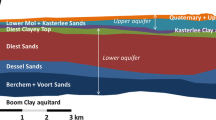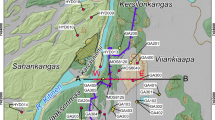Abstract
Ongoing developments in geological and hydrogeological investigation techniques, especially direct-push methods, have led to an increase in the quality, density and spatial resolution of data available from such investigations. This has created new challenges in the development of numerical models in terms of accurately and efficiently translating detailed and complex conceptual models into effective numerical models. Suitable geometrical and numerical modelling tools are essential in order to meet these challenges. This paper describes the development of a three-dimensional hydrogeological flow model for a contaminated site near Berlin, Germany, based on high-resolution geological data obtained principally using direct-push methods. The available data were first interpreted to construct a detailed GIS-based geological model, which formed the basis of the conceptual site model. The conceptual model was then translated into a geometrical model, which was used to create a finite element numerical model. An innovative geometry object-based approach enabled the complex structural details of the conceptual model to be accurately reproduced in the numerical model domain. The resulting three-dimensional steady-state unconfined flow model was successfully calibrated using external automated calibration software, whereby parameter values for groundwater recharge and hydraulic conductivity were determined.








Similar content being viewed by others
References
Bagrov NA (1953) On multi-year average of evapotranspiration from land surface (in Russian). Meteorog i Gridrolog 10:20–25
Bear J (1972) Dynamics of fluids in porous media. Elsevier, New York
Beinhorn M (2005) Contributions to computational hydrology: non-linear flow processes in subsurface and surface hydrosystems. PhD Thesis, Universität Tuebingen, Germany
Carrera J, Neuman S (1986) Estimation of aquifer parameters under transient and steady state conditions. Water Resour Res 22(2):199–242
Chen C (2006) Integrating GIS methods for the analysis of GeoSystems. PhD Thesis, Universität Tuebingen, Germany
Dietrich P and Leven C (2005) Direct push technologies. In: Kirsch R (ed) Groundwater geophysics, Springer, Berlin Heidelberg New York, pp 321–340
Doherty J (2004) PEST. Watermark computing, Corinda, Australia
ESRI (1998) ESRI shapefile technical description. Environmental Systems Research Institute, Inc. http://www.esri.com/library/whitepapers/pdfs/shapefile.pdf
Glugla G and Müller E (1997) Grundwasserneubildung als Komponente der Abflußbildung. Freiburger Schriften zur Hydrologie, 5
Gronewold J (2006) Development of an internet information system for the modelling of natural attenuation processes in groundwater (in German). PhD Thesis, Universität Tuebingen, Germany
Hazen A (1911) Discussion: dams on sand foundations. Transactions, American Society of Civil Engineers 73:199
Hill MC (1992) A computer program (MODFLOWP) for estimating parameters of a transient, three-dimensional, ground-water flow model using nonlinear regression. U.S. Geological Survey Open-File Report 91–484
Hill MC (1998) Methods and guidelines for effective model calibration. U.S. Geological Survey Water-Resources Investigations Report 98–4005
Kalbacher T (2006) Geometric modelling and 3D-visualisation of hydrogeological systems: software design and application. PhD Thesis, Universität Tuebingen, Germany
Kalbacher T, Mettier R, Kosakowski G, Kolditz O (2006) Geometric modelling and object-oriented software concepts applied to a heterogeneous fracture network from grimsel rock laboratory. Comput Geosci (submitted). DOI: 10.1007/s10596-006-9032-8
Kolditz O, Xie M, Kalbacher T, Bauer S, Wang W, McDermott C, Chen C, Beyer C, Gronewold J, Kemmler D, Walsh R, Du Y, Park C-H, Hess M, Bürger C, Delfs J-O (2006) GeoSys/Rockflow—user manual. University of Tuebingen, Center for Applied Geoscience, http://www.uni-tuebingen.de/zag/geohydrology/geosys
Poeter BP, Hill MC (1997). Inverse models: a necessary next step in ground water modeling. Ground Water 35(2):250–260
Robertson PK (1990) Soil classification using the cone penetration test. Can Geotech J 27:151–158
Robertson PK, Campanella RG (1983a) Interpretation of cone penetration tests: Part I: Sand. Can Geotech J 20:719–733
Robertson PK, Campanella RG (1983b) Interpretation of cone penetration tests: Part II: Clay. Can Geotech J 20:734–745
Schulmeister MK et al (2003) Direct-push electrical conductivity logging for high-resolution hydrostratigraphic characterization. Ground Water Monit Remediat 23(3):52–62
Shewchuk JR (1996) Engineering a 2D quality mesh generator and Delaunay triangulator. Applied computational geometry: towards geometric engineering. Springer, Berlin Heidelberg New York, pp 203–222
Wang W and Kolditz O (2006) Object-oriented finite element analysis of thermo-hydro-mechanical (THM) problems in porous media, vol 68. Int J Numer Methods Eng, 16 May 2006 (published online). DOI: 10.1002/nme.1770
Acknowledgments
This work is funded by the German Ministry of Education and Research (BMBF) under grants 02WN0352 and 0330512 as a part of the KORA priority program, sub-projects 1.2 and 7.1 and additional funding from the Brandenburgische Boden Gesellschaft für Grundstücksverwaltung und—verwertung mbH (BBG).
Author information
Authors and Affiliations
Corresponding author
Rights and permissions
About this article
Cite this article
Miles, B., Kalbacher, T., Kolditz, O. et al. Development and parameterisation of a complex hydrogeological model based on high-resolution direct-push data. Environ Geol 52, 1399–1412 (2007). https://doi.org/10.1007/s00254-006-0582-9
Received:
Accepted:
Published:
Issue Date:
DOI: https://doi.org/10.1007/s00254-006-0582-9




